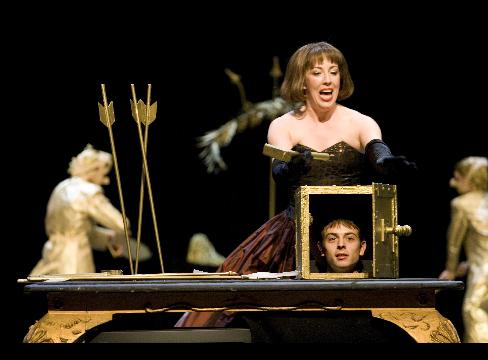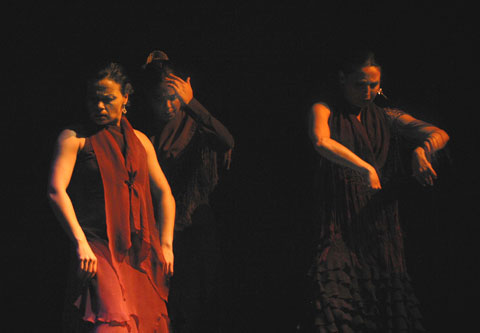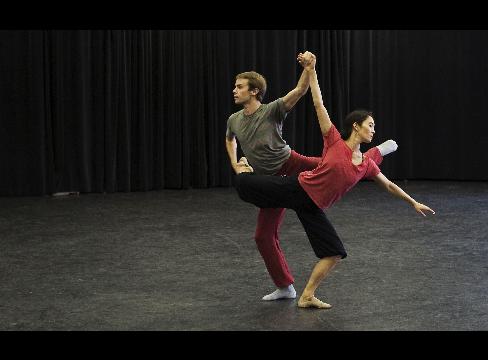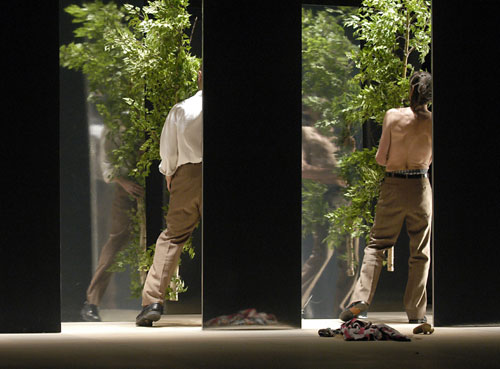Seeing Things: July 2008 Archives
It's summer, the lazy season, and dancing, which never rests, has taken to outdoor venues.
The full article appeared in Voice of Dance (http://www.voiceofdance.org) on July 30, 2008. To read it, click here.
This article originally appeared in the Culture section of Bloomberg News on July 19, 2008.

Helen Pickett as Agnes, top, and Jim De Block as Mr. Pnut take part in the Royal Ballet of Flanders production of "Impressing the Czar" on Nov. 22, 2005. The ballet, created by William Forsythe in 1988, will be performed by the Royal Ballet of Flanders at the Rose Theater in New York as part of the Lincoln Center Festival through July 20, 2008. Photographer: Johan Persson/Royal Ballet of Flanders via Bloomberg News
July 19 (Bloomberg) -- Imagine an evening-length ballet with two unfathomable sections of pretentious chaos and frenzy surrounding an oasis of logic and calm.
That's ``Impressing the Czar,'' created by William Forsythe in 1988 for Ballett Frankfurt, reconstructed by the Royal Ballet of Flanders in 2005 and now brought by that troupe to Manhattan's Rose Theater, where it runs through tomorrow as part of the Lincoln Center Festival.
Acts I and III are busy and loud, jam-packed with action and lacking in sense but crammed full of stuff: people rushing about to a foolish mix of music; raucous, often patently silly, spoken text; a conglomeration of dance styles, ballet basics predominating; gold-painted props portentously exuding ambiguous meanings; gorgeous or outlandish clothes inspired by different locales and times.
What is Forsythe trying to tell us? In Act I, that past eras of art are rich in treasures but that we're poor custodians of them, treating them as if they were interchangeable parts of the present moment? In Act III, that the culture, in which everything is for sale, has gone to hell in a hand basket? Your guess is as good as mine, probably better; I have little patience for highbrow shenanigans.
The second of the ballet's three acts, ``In the Middle, somewhat elevated,'' has nine dancers in practice clothes, a pair of golden cherries hanging above them, execute an abstract work that Forsythe made for the Paris Opera Ballet in 1987. The next year it became the centerpiece of ``Czar'' and is now danced on its own by several distinguished classical companies.
Cool Chic
Although the Flanders performers are earthier, less finely honed than the Paris crowd, you can still see the cool chic of the choreography. There's no postmodern froufrou here; Forsythe relies on the intricacies and beauties of more complex classical steps and on form and pattern, mingled judiciously with pedestrian actions like strolling, running and just hanging out, watching. It did him a world of good.
Aki Saito stood out in this section, her movement now like the slice of a lethally sharp knife, now melting like chocolate in the sun.
The inordinately ambitious choreographer is trying to do three things in ``Impressing the Czar.'' Not content with emulating Balanchine with ``In the Middle,'' he wants to outdo him. Balanchine took Marius Petipa's 19th-century achievement forward, building from it -- and from his own genius -- ballets that would define classical dance in the 20th century and beyond.
No Balanchine
Forsythe, certainly a talent though hardly on the scale of Balanchine, wants to be the man who revitalizes the genre for the 21st century. Yet his deconstruction of the technique he's inherited from his role model remains theoretical -- handsome enough but devoid of feeling.
In the first and final acts, Forsythe wants to indulge his interest in art and architecture, which is keen, tasteful, even imaginative -- though it often overwhelms the movement. He also seems to think that if spectators fail to be impressed by the intellectual underpinning he claims for his choreography, they'll find some thrills in the gaudy chaos and violence to which he gives full rein in this rule-breaking extravaganza.
It's easy to see that these aims are incompatible.
At the Rose Theater, Broadway at West 60th Street; +1-212-721-6500; http://www.lincolncenter.org.
© 2008 Bloomberg L.P. All rights reserved. Reprinted with permission.
Noche Flamenca
Theater 80, 80 St. Mark's Place, NYC / July 9-August 12, 2008

The cast members work as a team to provide mounting excitement, but Soledad Barrio is still the one who takes you to places you might never have reached without her, emotional states that bare the toughest truths about human existence.
The full article appeared in Voice of Dance (http://www.voiceofdance.org) on July 15, 2008. To read it, click here.
This article originally appeared in the Culture section of Bloomberg News on July 7, 2008.

Noah Vinson and Maile Okamura dance during a rehearsal of Mark Morris' "Romeo & Juliet, On Motifs of Shakespeare," in New York, on June 11, 2008. Photographer: Johan Henckens/Mark Morris Dance Group via Bloomberg News
July 7 (Bloomberg) -- Leave it to Mark Morris to create a ``Romeo and Juliet'' danced to Prokofiev that features no balcony, no crypt, no pointe work, plenty of passion and violence, yet no final tragedy. The lovers simply move on to some higher plane, enveloped in a star-studded sky.
Morris, 51, is fanatically committed to presenting his dances with live music, so it's only fitting that this celebrated and controversial choreographer should be the first ever to use Prokofiev's recently recovered original score for the world premiere of ``Romeo and Juliet, On Motifs of Shakespeare'' as part of Bard College's Summerscape Festival.
Material for the reconstruction of the score was recently discovered in a Moscow archive by musicologist Simon Morrison. This original version, occasionally dissonant and rhythmically complex, was intended to show passionate youth challenging feudal conventions about marriage and family. (The blissful-end narrative was worked out with the experimental theater director Sergey Radlov.) It was barred from production by both the Soviet regime and ballet community beginning in 1935.
Desperate to see his work staged, Prokofiev resigned himself in 1940 to a more bombastic and melodramatic alternative, now familiar to dance fans from productions by the Kirov Ballet's Leonid Lavrovsky, then by John Cranko, Kenneth MacMillan and Frederick Ashton, to name a few.
Homemade Air
The production at Bard, in Annandale-on-Hudson, New York, uses the original music and offers many aspects of enchantment, though it hardly eclipses MacMillan's pull-out-the-stops extravaganza. Morris's version is tastefully small -- fewer than 20 dancers and a single set -- and captures the beguiling, homemade air of talented kids putting on a show.
It also relinquishes class distinctions to a great degree. Juliet's parents, for example, mingle with the throngs in the town square as friendly neighbors of women who don't even own shoes. The human intimacy of the whole affair is well matched to Bard's exquisitely proportioned, 500-seat Richard B. Fisher Center for the Performing Arts.
The choreography mixes a rather thin ballet vocabulary with robust modern dance and folk touches and lusty, centuries-old Italian mime -- a typical Morris blend. One of the best elements of the production, rare for this choreographer, is the detail with which the principals reflect the most fleeting emotion.
Tender Romeo
Rita Donahue as Juliet goes from the touching confusion of an inexperienced teen making her social debut to incredulous delight in David Leventhal's Romeo, who has crashed the party. Leventhal, whose initial reticence is wimpy, gains confidence by quick degrees from Juliet's response, assuring us (and her) that he will always treat her tenderly. This is fortunate because, in a unique interpretation, Bradon McDonald's Paris, the suitor with the senior Capulets' approval, acts as if he owns the girl, repelling her with his rough handling.
Lauren Grant is terrific as the Nurse (more of a multipurpose servant who participates in all of the family's affairs). As Prince Escalus, Joe Bowie's putting down the latest melee in the Capulet-Montague feud was my favorite passage. Resplendent in the black and gold of his authority, he faces the crowd in the blood-soaked town square and, with grave, calm gestures, preaches that reconciliation is the only path to peace.
The gender switch in the casting of Amber Darragh as Mercutio and Julie Worden as Tybalt was fun yet unconvincing. The biggest disappointment was the quartet of senior dancers -- now retired from the company, though some of the most memorable artists it has ever had -- summoned back to play the Capulet and Montague parents. Three had nothing meaningful to do; the fourth seemed not to include dramatic imagination among her gifts.
Leon Botstein conducted the American Symphony Orchestra in a sensitive reading of the score. Allen Moyer contributed handsome, clever scenery with a childlike air, raw-looking wood prevailing from swords to miniature houses representing Verona. Martin Pakledinaz was at less than his personal best with the costumes.
Mark Morris Dance Group and American Symphony Orchestra perform ``Romeo and Juliet, On Motifs of Shakespeare'' through July 9 at Bard Summerscape Festival, Annandale-on-Hudson, New York. Information: +1-845-758-7926; http://summerscape.bard.edu.
The $1.1 million production will travel to Berkeley, California, Sept. 25-28; London, Nov. 5-8; Urbana, Illinois, March 13-14; Norfolk, Virginia, May 8-10; New York's Lincoln Center, May 14-17; and Chicago, September 2009.
© 2008 Bloomberg L.P. All rights reserved. Reprinted with permission.
Compagnie Maguy Marin: Umwelt
Joyce Theater, NYC / June 17-22, 2008

Compagnie Maguy Marin in Maguy Marin's Umwelt. Photo by Ganet.
Commentators claim that Marin, inspired by Samuel Beckett, considers the actions banal and underlines that quality by reiterating them obsessively. I suspect she has a trick card up her sleeve. They certainly don't look banal to me; I think they take on an epic radiance. I'd guess that Marin is observing the everyday world and saying "Wow! Just look at that!"
The full article appeared in Voice of Dance (http://www.voiceofdance.org) on June 24, 2008. To read it, click here.
Sitelines
AJ Ads
 360° Dance Company at DTW offers two socially relevant revivals, Jane Dudley’s solo “Time Is Money” (1932) and Mary Anthony’s “Devil in Massachusetts” (1952) as well as the World Premier of Artistic Director, Martin Lofsnes' "6-1".
360° Dance Company at DTW offers two socially relevant revivals, Jane Dudley’s solo “Time Is Money” (1932) and Mary Anthony’s “Devil in Massachusetts” (1952) as well as the World Premier of Artistic Director, Martin Lofsnes' "6-1".
AJ Blogs
AJBlogCentral | rssculture
Terry Teachout on the arts in New York City
Andrew Taylor on the business of arts & culture
rock culture approximately
Laura Collins-Hughes on arts, culture and coverage
Richard Kessler on arts education
Douglas McLennan's blog
Dalouge Smith advocates for the Arts
Art from the American Outback
Chloe Veltman on how culture will save the world
For immediate release: the arts are marketable
No genre is the new genre
David Jays on theatre and dance
Paul Levy measures the Angles
Judith H. Dobrzynski on Culture
John Rockwell on the arts
innovations and impediments in not-for-profit arts
Jan Herman - arts, media & culture with 'tude
dance
Apollinaire Scherr talks about dance
Tobi Tobias on dance et al...
jazz
Howard Mandel's freelance Urban Improvisation
Focus on New Orleans. Jazz and Other Sounds
Doug Ramsey on Jazz and other matters...
media
Jeff Weinstein's Cultural Mixology
Martha Bayles on Film...
classical music
Fresh ideas on building arts communities
Greg Sandow performs a book-in-progress
Harvey Sachs on music, and various digressions
Bruce Brubaker on all things Piano
Kyle Gann on music after the fact
Greg Sandow on the future of Classical Music
Norman Lebrecht on Shifting Sound Worlds
Joe Horowitz on music
publishing
Jerome Weeks on Books
Scott McLemee on books, ideas & trash-culture ephemera
theatre
Wendy Rosenfield: covering drama, onstage and off
visual
Public Art, Public Space
Regina Hackett takes her Art To Go
John Perreault's art diary
Lee Rosenbaum's Cultural Commentary
